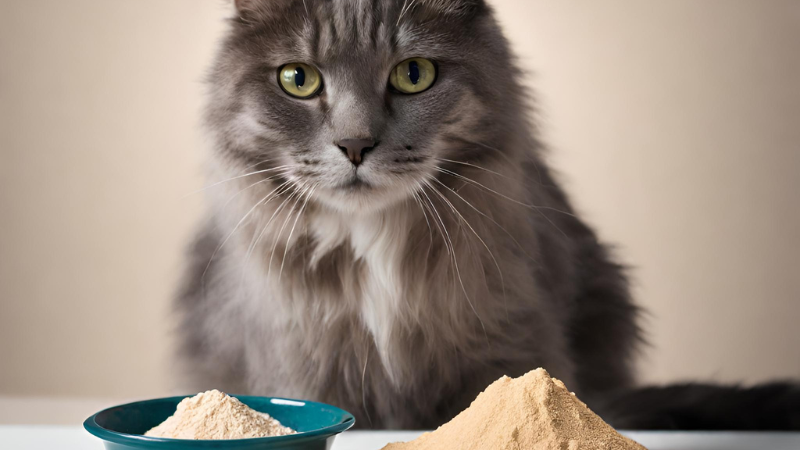Blood sprinkles for cats are a potential sign of an underlying health issue, requiring immediate veterinary attention. Now, let’s dive into the topic and explore what blood sprinkles in cats may indicate.
Cats are known for their curious nature and occasional scrapes and scratches. However, when you notice blood sprinkles on your cat, it could be a red flag indicating a more serious problem. Blood sprinkles, also known as hematuria, can occur due to various reasons such as urinary tract infections, bladder stones, trauma, or even kidney disease.
It is crucial to identify the underlying cause to ensure proper treatment and prevent any potential complications. We will explore the possible causes of blood sprinkles in cats, their symptoms, and the course of action to take when faced with this concerning issue. So, if you notice blood sprinkles on your furry friend, read on to gain a better understanding of what could be going on and how to best address the situation.
Causes Of Blood Sprinkles In Cats
Observing blood sprinkles in your beloved feline companion’s urine can be a cause for concern. While it can be distressing to witness, understanding the potential causes behind this condition can help you take appropriate action. Different factors can contribute to blood sprinkles in cats, including infections, bladder stones, and urinary tract infections (UTIs).
Infections
One of the primary causes of blood sprinkles in cats is urinary tract infections. These infections typically occur when bacteria enter a cat’s urinary tract, leading to inflammation and irritation. As a result, small amounts of blood may appear in the urine. Some common symptoms accompanying urinary tract infections include frequent urination, straining while urinating, and an increased desire to drink water.
Bladder Stones
Another potential cause of blood sprinkles in cats is the presence of bladder stones. These stones, which can vary in size and composition, form in the bladder when minerals or other substances accumulate and harden. When a cat with bladder stones urinates, the stones may irritate the bladder lining, leading to bleeding and the appearance of blood in the urine. In addition to blood in the urine, signs of bladder stones can include straining in the litter box, frequent urination, and discomfort during urination.
Urinary Tract Infections
Urinary tract infections (UTIs) in cats can also result in blood sprinkles in the urine. Similar to humans, cats can develop UTIs that affect their urethra, bladder, or kidneys. Bacteria, most commonly E. coli, are often the culprits behind these infections. When a cat has a UTI, the irritation and inflammation caused by bacteria can lead to blood in the urine. You might also notice your cat experiencing discomfort during urination, excessive grooming of the genital area, and an unusual odor from their urine.
Raw Paws Boost Pet Food Topper Freeze-Dried Beef Liver

Signs And Symptoms Of Blood Sprinkles In Cats
Blood sprinkles in cats can present with signs such as blood in the urine, blood in the stool, bleeding from the nose or gums, and pale gums. It is essential to seek veterinary care for proper diagnosis and treatment.
Cats are known for their independence and can sometimes be quite secretive about their health problems. However, it is important for cat owners to be vigilant and watch out for any signs and symptoms that could indicate a possible health issue. One such concern is blood sprinkles in the cat’s urine. If you notice any of the following signs, it might be an indication that your cat is experiencing blood sprinkles.
Tartar Shield Dental Sprinkles | Dog & Cat Food Topper Additive

Visible Blood In The Urine
When you clean your cat’s litter box, take a moment to examine the urine clumps closely. If you see any red or rust-colored stains, this could be a sign of blood in the urine. It’s essential to differentiate between blood sprinkles and actual blood clots, as the latter may indicate a more severe condition. If you consistently spot blood in your cat’s urine, it’s crucial to consult your veterinarian for a proper diagnosis and appropriate treatment.
Frequent Urination
A sudden increase in the frequency of urination can be another sign of blood sprinkles in cats. If you notice that your feline friend is visiting the litter box more often than usual, it could be an indication of a urinary tract infection or bladder irritation. Additionally, your cat may seem restless or anxious while trying to urinate. To rule out any potential underlying health issues, it is advisable to seek veterinary attention promptly.
Pain Or Discomfort During Urination
Cats experiencing blood sprinkles in their urine may show signs of pain or discomfort during urination. They may cry out or exhibit signs of distress while using the litter box. You may also notice your cat excessively licking their genital area in an attempt to find relief. These behaviors suggest that your cat is experiencing discomfort, and it is vital to address the issue promptly to alleviate their discomfort and prevent any further complications. In conclusion, blood sprinkles in a cat’s urine can be an indication of an underlying health problem that requires attention.
By being alert to the signs and symptoms such as visible blood in the urine, frequent urination, and pain or discomfort during urination, cat owners can ensure their furry friends receive the necessary care and treatment. Remember, early detection and timely intervention play a crucial role in maintaining your cat’s wellbeing. If you notice any of these signs, it is always best to consult with a veterinarian for a proper diagnosis and guidance.
Diagnosing Blood Sprinkles In Cats
Unexplained blood sprinkles in a cat’s urine can be a cause for concern. It is important to identify the underlying cause and seek appropriate treatment. There are several diagnostic methods that veterinarians use to determine the cause of blood sprinkles in cats.

Physical Examination
A comprehensive physical examination is the starting point in diagnosing blood sprinkles in cats. During this examination, the veterinarian will carefully assess the cat’s overall health and look for any visible signs of distress. They will palpate the abdomen to check for any abnormalities or tenderness.
In addition, the veterinarian will check the cat’s vital signs, including heart rate, respiratory rate, and body temperature. This information can provide valuable insights into the cat’s overall well-being. Any physical abnormalities or abnormalities detected during this examination can help narrow down the potential causes of blood sprinkles.
Urinalysis
Urinalysis is a crucial diagnostic tool in determining the cause of blood sprinkles in cats’ urine. A urine sample is collected from the cat and analyzed for various factors, including red blood cells, white blood cells, bacteria, crystals, and pH levels.
High levels of red blood cells in the urine can indicate a urinary tract infection, bladder stones, or kidney disease. White blood cells may suggest inflammation or infection in the urinary tract. Bacteria and crystals, such as struvite or calcium oxalate, can also provide insights into the potential causes of blood sprinkles.
Based on the results of the urinalysis, the veterinarian can make a more accurate diagnosis and recommend appropriate treatment options.
Imaging Tests
In some cases, imaging tests may be necessary to further evaluate the source of blood sprinkles in cats. These tests can help visualize the urinary system and identify any structural abnormalities or tumors that may be causing the issue.
Common imaging tests used in diagnosing blood sprinkles in cats include X-rays and ultrasounds. X-rays can provide detailed images of the urinary tract, aiding in the detection of bladder stones or tumors. Ultrasounds, on the other hand, can offer real-time visualization and help identify any abnormalities or inflammation in the kidneys, bladder, or urethra.
By utilizing these imaging tests, veterinarians can gain a clearer understanding of the underlying cause of blood sprinkles in cats and develop an effective treatment plan.

Treatment Options For Blood Sprinkles In Cats
Blood sprinkles, also known as petechiae, are small red spots caused by bleeding under the skin. While it can be alarming to see blood sprinkles on your cat, it is important to identify the underlying cause and seek appropriate treatment. The treatment options for blood sprinkles in cats can vary depending on the underlying cause and severity of the condition. Here are some common treatment options:
Medication
In certain cases, medication may be prescribed by your veterinarian to treat the underlying cause of blood sprinkles in cats. Some medications that may be recommended include:
- Antibiotics: If the blood sprinkles are caused by an infection, antibiotics may be prescribed to eliminate the infection and reduce inflammation.
- Antihistamines: If the blood sprinkles are caused by an allergic reaction, your veterinarian may prescribe antihistamines to relieve the itching and reduce the appearance of blood sprinkles.
- Corticosteroids: In cases where the blood sprinkles are caused by immune-related disorders, corticosteroids may be prescribed to reduce inflammation and suppress the immune response.
Dietary Changes
Dietary changes can play a significant role in managing blood sprinkles in cats, especially if the condition is caused by nutritional deficiencies or food allergies. Your veterinarian may recommend:
- Switching to a hypoallergenic diet: If your cat is diagnosed with a food allergy, switching to a hypoallergenic diet can help eliminate the triggers and reduce the occurrence of blood sprinkles.
- Supplementing with vitamins and minerals: If blood sprinkles are caused by nutritional deficiencies, your veterinarian may recommend adding specific vitamins and minerals to your cat’s diet to address the deficiencies.
- Eliminating potential allergens: If certain ingredients in your cat’s diet are suspected to be causing an allergic reaction, they should be avoided to prevent the appearance of blood sprinkles.
Surgery
In more severe cases, surgical intervention may be necessary to treat the underlying cause of blood sprinkles. Surgery options include:
- Tumor removal: If the blood sprinkles are caused by a tumor or abnormal growth, surgical removal may be performed to eliminate the source of bleeding.
- Repair of blood vessel abnormalities: Rarely, blood sprinkles may result from abnormalities in the blood vessels. In such cases, surgery may be required to correct the abnormality and prevent further bleeding.
- Other surgical procedures: Depending on the specific underlying cause, your veterinarian may recommend other surgical procedures to address the condition and alleviate the appearance of blood sprinkles.
It is important to consult with your veterinarian to determine the most appropriate treatment option for your cat’s blood sprinkles. They will be able to provide a comprehensive diagnosis and recommend the best course of action to address the underlying cause and improve your cat’s overall health and well-being.
Preventing Blood Sprinkles In Cats
Preventing blood sprinkles in cats is an important aspect of their overall health and well-being. Blood sprinkles, also known as hematuria, can be a sign of underlying medical issues that require attention. By taking proactive measures and following certain guidelines, cat owners can help reduce the occurrence of blood sprinkles in their feline companions.
Proper Hydration
One of the key factors in preventing blood sprinkles in cats is ensuring proper hydration. Dehydration can lead to concentrated urine, which increases the chances of urinary tract infections and bladder issues. To keep your cat adequately hydrated, make sure they always have access to fresh water. Consider providing multiple water sources throughout your house and try using a water fountain as cats are often more inclined to drink moving water. Additionally, wet food can also contribute significantly to their hydration.
Regular Veterinary Check-ups
Regular veterinary check-ups play a crucial role in maintaining your cat’s urinary health. Veterinarians are trained to identify early signs of urinary problems and can provide necessary treatment or preventive measures. Schedule routine check-ups for your feline friend at least once a year. During these visits, the vet can perform a thorough examination, including checking for any signs of blood in the urine. Timely detection of issues can help prevent the development of more serious conditions.
Maintaining A Clean Litter Box
A clean litter box is not only essential for your cat’s hygiene but also helps prevent urinary tract issues that can lead to blood sprinkles. Cats are naturally clean creatures, and an unclean litter box can deter them from using it regularly. Proper litter box hygiene involves scooping the box daily to remove waste and clumps, and completely replacing the litter on a regular basis. Additionally, consider using unscented litter as strong scents can be overwhelming for cats and may discourage them from using the litter box.
By following these guidelines, cat owners can take proactive steps to prevent blood sprinkles in their feline companions. Ensuring proper hydration, regular veterinary check-ups, and maintaining a clean litter box are all crucial aspects of a comprehensive approach to urinary health for cats.
Frequently Asked Questions For Blood Sprinkles For Cats
What Is Blood Sprinkles?
Blood sprinkles are a decorative addition to desserts that resemble tiny red dots. They are typically made with food coloring or edible glitter and can be used to enhance the visual appeal of cakes, cupcakes, and other desserts.
Is Blood Powder Good For Cats?
Yes, blood powder can be beneficial for cats. It provides essential nutrients and supports their overall health. However, it is crucial to consult with a veterinarian before adding it to your cat’s diet.
Is Blood Meal Safe For Cats?
Yes, blood meal is safe for cats as it is a natural source of nutrients for their diet. It provides essential proteins and minerals. However, it’s important to feed it in moderation as excessive amounts can cause digestive issues. Always consult with a veterinarian before making any changes to your cat’s diet.
Are Pink Zebra Sprinkles Safe For Cats?
Pink zebra sprinkles are not safe for cats due to their artificial coloring and potential harmful ingredients. It is important to keep your feline friends away from any food products that could be toxic to them and stick to cat-safe treats instead.
Conclusion
To conclude, blood sprinkles for cats can be a valuable addition to their diet, providing essential nutrients and aiding in their overall health and well-being. By carefully incorporating this supplement into their meals, cat owners can ensure their feline companions receive the necessary vitamins and minerals.
Remember to consult with a veterinarian before making any dietary changes and to always prioritize your cat’s health. With blood sprinkles, your furry friend can thrive and purr with contentment.







